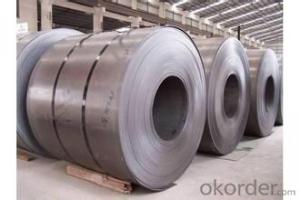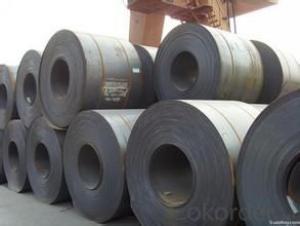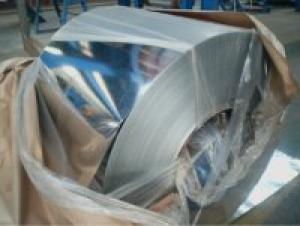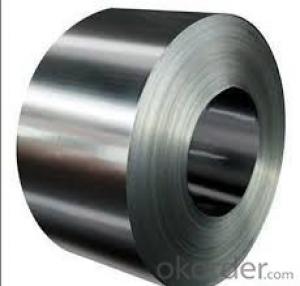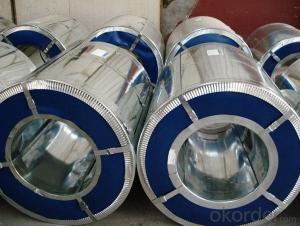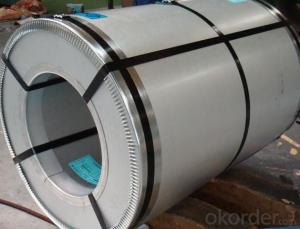Hot Rolled Steel Sheet/ Coil in Good Quality
- Loading Port:
- Tianjin
- Payment Terms:
- TT OR LC
- Min Order Qty:
- 100 m.t.
- Supply Capability:
- 500000 m.t./month
OKorder Service Pledge
OKorder Financial Service
You Might Also Like
Rolled to its final dimensions while it’s hot enough to scale, our hot-rolled steel is an amalgamation of the various qualities of steel. It can be in the form of plates, sheets and coils. Our Hot-Rolled Steel Sheets and Coils are applied to a wide range of uses such as automobile, electrical appliance, machinery manufacturing, container manufacturing, shipbuilding, bridge, pipeline, and receive high acclaim from our customers for its excellent quality.
Product Description:
HOT-ROLLED STEEL COIL
Hot rolled low hardness, easy processing, good ductility.
Available specification:
| thickness | width(mm) | length(mm) | coil inside diameter(mm) | |
HOT ROLLED STEEL COIL | 1.5-25 | 600-2000 | 762 | |
HOT ROLLED STEEL STRIP | 1.5-20 | 30-720 | 762 | |
HOT ROLLED STEEL PLATE | 6-700 | 500-4500 | 4000-18000 | |
HOT ROLLED STEELSHEET | 1.2-25 | 50-2000 | 0-18000 |
we can supply all these inndustrial materials with reasonable price and high quality.
We can ensure that stable quality standards are maintained, strictly meeting both market requirements and customers’ expectations. Our products enjoy an excellent reputation and have been exported to Europe, South-America, the Middle-East, Southeast-Asia, Africa and Russia etc.. We sincerely hope to establish good and long-term business relationship with your esteemed company.
- Q:What processes and materials are used in the production of chrome steel
- Go to the process section and find point 6 (explains when alloys are added). Chrome is added at this point, usually in the form of ferrochrome alloy (FeCr). Many kinds of chrome steel also contain nickel. The strengthening effect on steel by forming stable carbide grains at the grain boundaries and the strong increase in corrosion resistance made chromium an important alloying material for steel. The high speed tool steels contain between 3 and 5% chromium.
- Q:How do steel coils contribute to fire resistance in buildings?
- Steel coils contribute to fire resistance in buildings in several ways. Firstly, steel coils have high melting points, which means they can withstand extremely high temperatures without losing their structural integrity. This helps prevent the collapse of the building during a fire. Additionally, steel coils have low thermal conductivity, meaning they do not readily transfer heat. This property helps to contain the spread of fire, preventing it from spreading rapidly within the building. Moreover, steel coils can be used to reinforce concrete structures, enhancing their fire resistance. By providing strength and stability to the building, steel coils play a crucial role in ensuring the overall fire safety of the structure.
- Q:What are the applications of steel coils in the aerospace industry?
- The aerospace industry relies heavily on steel coils for various purposes. One important application is in the manufacturing of aircraft structures. Steel coils are commonly used to fabricate wing spars, fuselage frames, and landing gear, as they possess high strength and durability necessary to withstand heavy loads and extreme conditions. Another significant use of steel coils in the aerospace industry is in the production of engine components, specifically turbine blades. These blades experience high temperatures and rotational forces, making it crucial to utilize steel coils due to their excellent heat resistance and mechanical properties. This ensures the reliability and performance of aircraft engines. Steel coils also find utilization in the production of fasteners and connectors necessary for securely joining different parts of an aircraft. Bolts, nuts, and rivets made from steel coils are essential for maintaining the structural integrity and safety of the aircraft. These fasteners need to possess high tensile strength and corrosion resistance. Furthermore, steel coils are employed in the production of fuel tanks and hydraulic systems. The weldability and formability of steel allow for the efficient fabrication of these complex structures. Steel coils can be shaped into various sizes and configurations, providing flexibility in designing fuel tanks and hydraulic components that meet specific requirements. In conclusion, steel coils are indispensable in the aerospace industry. Their use in aircraft structures, engine components, fasteners, and fuel tanks highlights their versatility and reliability. The exceptional strength, durability, heat resistance, and formability of steel make it the preferred material for various aerospace applications, ultimately ensuring the safety and performance of aircraft.
- Q:Steel seems to be much less expensive. What is the reason why? I've heard steel will ruin a barrel after time....is that true? But with the price difference maybe it don't matter? Is steel reliable? What are the negatives about steel I should know before buying?
- I guess you dont get out much or read the news. Brass - is mostly copper. And ever since the earthquake that decimated the west coast of South America 3 or 4 years ago and crippled the biggest copper producing area in the world - anythng made with copper - wire, buss bars, brass items etc, the cost has gone up 5x and not really gone back to what they were. The steel - is in the case, not the bullet. So, your worries about ruining the barrel are unfounded. The only drawback to steel case ammo - they are coated with a lacquor to prevent rust - is when you go burn off 3 or more mags in quick secession and then leave a live one in the chamber. The quick firing will heat up the barrel - enough to melt the lacquor. Leave a live round in it - it wont come out without firing. Onced this happens - excellent chance all the next rounds will jam until you clean the chamber with mineral spirits or other solvent and a brass brush. Like all things in life - when you use the generic product in 'moderation' things work ok. The only time you will be unhappy to have bought steel case ammo - is when you decide to reload. You cant handload steel - only brass does this. And smart people who are preppers and do not reload but rely on a 5.56mm rifle for protection - save thier brass. Because some day their might be an ammo shortage - I know, it's a stretch and will never happen - and having that reloadable brass means they can make more. You put 2 or 3 pounds of 4198 powder and one brick of small rifle primers in a cool dry place - this would be an even smarter thing. And a 1K box or two of Armscor 62gr fmj with the brass gives you an A in my book for being prepared. Much easier to store a few cans of powder than several thouand rounds of ammo. Toss that brass and projectiles in the garage or under the house.
- Q:and what type of metal is steel?
- Steel comes from iron ore nuggets,only larger kind of like gold..it is melted down ..called smelting..it is iron.
- Q:What are the common certifications required for steel coils?
- The certifications needed for steel coils differ based on the industry and purpose of the coils. However, there are various certifications that are commonly requested. 1. ISO 9001: This certification ensures that the manufacturer has established a quality management system that meets global standards. It confirms that the manufacturer has the necessary procedures and controls in place to consistently produce high-quality steel coils. 2. ISO 14001: This certification concentrates on environmental management systems. It guarantees that the manufacturer is dedicated to minimizing its environmental impact and reducing waste during the production process. 3. ISO 45001: This certification relates to occupational health and safety management systems. It ensures that the manufacturer has implemented measures to safeguard the health and safety of its employees and stakeholders. 4. ASTM International Standards: The American Society for Testing and Materials (ASTM) has introduced various standards for steel coils. These standards include chemical composition, mechanical properties, and dimensional tolerances. Adhering to these standards guarantees that the coils meet the specified requirements and are suitable for their intended use. 5. EN Standards: The European Committee for Standardization (CEN) has developed a series of standards for steel coils, known as EN standards. These standards cover similar aspects as ASTM standards but are specific to the European market. 6. JIS Standards: The Japanese Industrial Standards (JIS) are widely used in the steel industry in Japan and other Asian countries. Complying with JIS standards ensures that the coils meet the specific requirements of the Japanese market. 7. Certifications specific to products: Depending on the application of the steel coils, additional certifications may be necessary. For instance, if the coils are intended for automotive use, certifications like ISO/TS 16949 (Quality Management Systems for the Automotive Industry) may be required. It is crucial to note that the specific certifications needed may differ based on the region, industry, and customer requirements. Manufacturers should consult their customers and industry standards organizations to determine the exact certifications necessary for their steel coils.
- Q:PLS tell me all Foam Steel Characteristics and use?Thanks
- Foam steel [often steel foam] is used in applications that require light weight but high rigidity and strength. Watertight doors on modern ships are often made of foam steel. Pressure doors on aircraft are possible uses. As we keep striving for lighter weights in cars, foam steel might have some useful applications in bodies. There is a technical paper online that is in .pdf format that has a good discussion of the process and characteristics of foam steel.
- Q:what is the difference between stainless steel 304 (AISI 304) and stainless steel 310 (AISI 310) COR-TEN A
- Weathering steel will rust, but the rust will be adherant and not flake off and be replaced by new rust. Therefore once it rusts it will pretty much stop rusting any more. One (severe) down side is that anything around it will be streaked with rust stains and it will look awful. Some bozo with the Texas Department of Transportation designed a number of freeway interchange overpasses here in Houston using Cor-Ten steel and all of the concrete supports are streaked with red rust stains and it looks like hell. Cameron built an office building here in Houston with a Cor-Ten facade and it is streaked with rust too. They should have gone ahead and spent the money and painted them, but they didn't.
- Q:How are steel coils used in the manufacturing of metal furniture?
- Steel coils are used in the manufacturing of metal furniture as they provide the raw material for forming different components, such as frames, legs, and support structures. These coils are processed and shaped through various manufacturing techniques like cutting, bending, and welding to create the desired furniture pieces. The strength, durability, and versatility of steel make it an ideal material for metal furniture, ensuring stability and longevity in the final products.
- Q:What is the process of slitting steel coils into narrower strips?
- The process of slitting steel coils into narrower strips involves feeding a large steel coil through a slitting machine. The machine uses circular blades or rotary knives to make precise cuts along the length of the coil, creating narrower strips. These strips are then rewound onto separate reels or spools, ready for further processing or shipment.
1. Manufacturer Overview |
|
|---|---|
| Location | |
| Year Established | |
| Annual Output Value | |
| Main Markets | |
| Company Certifications | |
2. Manufacturer Certificates |
|
|---|---|
| a) Certification Name | |
| Range | |
| Reference | |
| Validity Period | |
3. Manufacturer Capability |
|
|---|---|
| a)Trade Capacity | |
| Nearest Port | |
| Export Percentage | |
| No.of Employees in Trade Department | |
| Language Spoken: | |
| b)Factory Information | |
| Factory Size: | |
| No. of Production Lines | |
| Contract Manufacturing | |
| Product Price Range | |
Send your message to us
Hot Rolled Steel Sheet/ Coil in Good Quality
- Loading Port:
- Tianjin
- Payment Terms:
- TT OR LC
- Min Order Qty:
- 100 m.t.
- Supply Capability:
- 500000 m.t./month
OKorder Service Pledge
OKorder Financial Service
Similar products
New products
Hot products
Hot Searches
Related keywords
